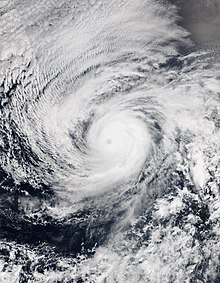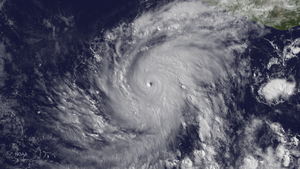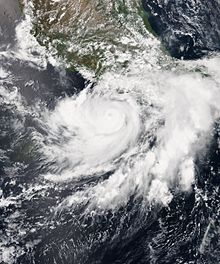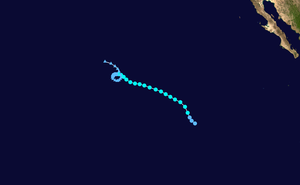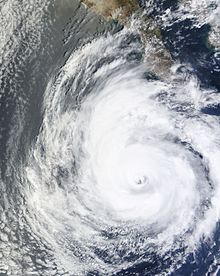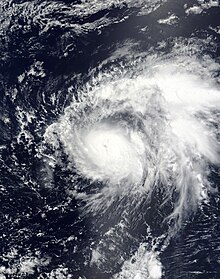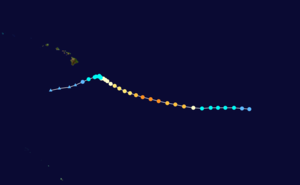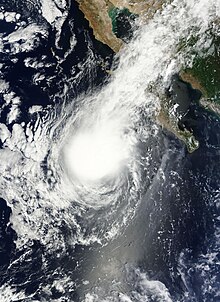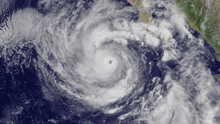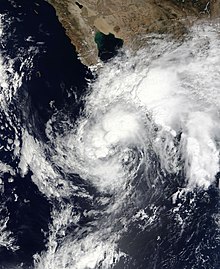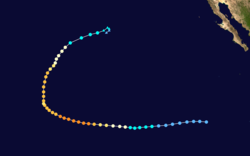2015년 태평양 허리케인 시즌 연표
Timeline of the 2015 Pacific hurricane season| 타임라인 2015년 태평양 허리케인 | |||||
|---|---|---|---|---|---|
 계절요약도 | |||||
| 계절 경계 | |||||
| 첫 번째 시스템 형성 | 2015년 5월 28일 | ||||
| 마지막 시스템이 소멸됨 | 2015년 12월 31일 (최신 기록) | ||||
| 최강의 시스템 | |||||
| 이름 | 패트리샤 (서반구에서 가장 심한 허리케인) | ||||
| 최대풍속 | 345km/h(215mph) (1분 지속) | ||||
| 최저 압력 | 872mbar(hPa; 25.75inHg) | ||||
| 가장 오래 지속되는 시스템 | |||||
| 이름 | 지메나 | ||||
| 기간 | 14.75일 | ||||
2015년 태평양 허리케인 시즌은 역대 두 번째로 활발한 태평양 허리케인 시즌으로,[1] 서반구에서 관측된 열대성 저기압 중 가장 강력한 사이클론을 특징으로 한다.허리케인 패트리샤.이 시즌은 공식적으로 5월 15일 140°W의 동쪽인 동태평양에서 6월 1일 국제 날짜 표시선과 140°W 사이의 중부 태평양에서 시작되어 11월 30일에 종료되었다.이 날짜는 일반적으로 대부분의 열대성 사이클론들이 북동 태평양 열대 사이클론 분지에서 형성되는 매년의 기간을 포함한다.[2]5월 28일 허리케인 안드레스가 개발되었고, 시즌 마지막 폭풍인 열대성 저기압 9-C는 시즌이 공식적으로 끝난 후인 12월 31일에 소멸되었다.
시즌 내내 31개의 열대성 저기압이 발달했고, 그 중 26개는 열대성 폭풍이 되었고, 그 중 16개는 기록적인 허리케인 강도에 도달했으며, 11개는 기록적인 허리케인 강도에 도달했다.[nb 1]중앙 태평양에서의 활동은 기록들을 산산조각 냈고, 16개의 열대 사이클로인이 분지에 형성되거나 분지에 유입되었다; 이전의 최고치는 1992년과 1994년 시즌 동안 11개였다.[4]8월 30일, 4등급 강도의 세 허리케인인 이그나시오, 히메나, 킬로가 북동 태평양에서 동시에 발생했는데, 이는 분지로는 처음이었다.[5]10월 23일 허리케인 패트리샤는 최소 대기압 872mbar(hPa; 25.75inHg)와 최대 지속풍속 시속 215mph(345km/h)로 서반구에서 기록된 가장 강력한 허리케인이 되었다.분지에서의 활동은 2014-16년 엘니뇨 사건이 발생하면서 비정상적으로 높은 해수면 온도와 낮은 수직 윈드 시어를 가져와서 수많은 시스템이 형성되고 강화되는 데 도움을 주었다.[6][7]
4개의 시간대를 유역에 활용한다.106.0 동쪽 폭풍의 중심지°W, 106.0부터 마운틴°W ~ 114.9°W, 태평양 115.0°W ~ 140.0°W,[8] 하와이-국제 날짜 표시선과 140°W 사이의 폭풍우용 알류샨.[9]그러나 편의상 모든 정보는 먼저 조정된 보편적 시간(UTC)에 의해 괄호 안에 포함된 각각의 현지 시간으로 나열된다.이 연대표에는 운영상 공개되지 않은 정보가 포함되어 있으며, 이는 국립 허리케인 센터와 중앙 태평양 허리케인 센터의 폭풍 후 검토 데이터가 포함됨을 의미한다.이 연대표는 열대 저기압의 형성, 강화, 약화, 지반하강, 열대변환 및 계절 동안의 소멸을 기록한다.
사건 연대표

5월
- 5월 15일
- 2015년 태평양 허리케인 시즌이 공식적으로 시작된다.[2]
- 5월 28일
- 06:00 UTC(오전 12:00 MDT)10°48′N 109°54′W / 10.8°N 109.9°W/ ( – 열대우울증 1-E는 바하 캘리포니아 반도의 남쪽 끝에서 남쪽으로 약 830 mi(1,335 km)[nb 2] 떨어진 곳에서 발달한다.[10]
- 12:00 UTC (6:00 a.m. MDT) at 11°06′N 111°00′W / 11.1°N 111.0°W – Tropical Depression One-E intensifies into a tropical storm and is named Andres while located 815 mi (1,310 km) south of the southern tip of the Baja California Peninsula.[10]
- 5월 29일
- 18:00 UTC (12:00 p.m. MDT) at 12°36′N 114°36′W / 12.6°N 114.6°W – Tropical Storm Andres intensifies to a Category 1 hurricane approximately 485 mi (780 km) southwest of Socorro Island.[10]
- 5월 30일
- 12:00 UTC(오전 5:00 PDT) 14°06′N 115°42 utW / 14.1°N 115.7°W/ 함 – 허리케인 안드레스는 소코로 섬 남서쪽 약 445mi(715km)의 카테고리 2 허리케인으로 강화된다.[10]
- 5월 31일
- 00:00 UTC (5:00 p.m. PDT, May 30) at 15°00′N 116°36′W / 15.0°N 116.6°W – Hurricane Andres intensifies to a Category 3 hurricane roughly 450 mi (725 km) southwest of Socorro Island.이로써 1971년 5월 이후 5번째 폭풍이 발생했다.[10]
- 12:00 UTC(오전 7:00 CDT) 12°00′N 102°12′W / 12.0°N 102.2°W/ 2 ( – 열대우울증 2-E는 멕시코 아카풀코에서 남서쪽으로 약 370 mi(595 km) 떨어진 지역에서 발달한다.[11]
6월
- 6월 1일
- 00:00 UTC (5월 31일 오후 5:00 PDT, 5월 31일) 15°18 atN 119°00′W / 15.3°N 119.0°W/ 0함 – 허리케인 안드레스는 소코로섬 서남서쪽 약 580mi(935km)의 카테고리 4 허리케인으로 강화된다.[10]
- 15°24에서 06:00 UTC(PDT, 5월 31일 오후 11:00)′N 119°30′W / 15.4°N 119.5°W/ 함 – 허리케인 안드레스는 소코로 섬의 서남서쪽 605mi(975km)에 위치한 동안 최대 지속 풍속 230km/h의 바람과 937mbar(hPa; 27.67inHg)의 기압으로 최고 강도에 도달한다.[10]
- 12:00 UTC(오전 7:00 CDT) 13°18′N 103°30′W / 13.3°N 103.5°W/ ( – 열대우울증 2-E는 멕시코 아카풀코 남서쪽 약 345 mi(555km)의 열대성 폭풍 블랑카로 격화한다.[11]
- 6월 2일
- 00:00 UTC (오후 5:00 PDT, 6월 1일) 16°18˚N 121°12˚W / 16.3°N 121.2°W/ (됨 – 허리케인 안드레스는 소코로 섬 서남서쪽 약 695 mi(1,120 km)의 카테고리 3 허리케인으로 약화된다.[10]
- UTC 06:00 (PDT, 6월 1일 오후 11:00) 16°54′N 121°54′W / 16.9°N 121.9°W/ (됨 – 허리케인 Andres는 소코로 섬 서남서쪽 약 730 mi(1,175 km)의 카테고리 2 허리케인으로 약화된다.[10]
- 17°24에서 12:00 UTC(오전 5:00 PDT)′N 122°42˚W / 17.4°N 122.7°W/ 됨 – 허리케인 안드레스는 소코로 섬 서쪽 약 775mi(1,245km)의 카테고리 1 허리케인으로 약화된다.[10]
- 12°54에서 18:00 UTC(오후 1:00 CDT)′N 104°30′W / 12.9°N 104.5°W/ (됨 – 열대성 폭풍 블랑카는 멕시코 지후아타네조 남남서쪽 약 410mi(660km)의 카테고리 1 허리케인으로 강화된다.[11]
- 6월 3일
- 06:00 UTC (6월 2일 오후 11:00 PDT, 6월 2일 오후 11:00) 18°54˚N 124°°N 124.7°W/ (됨 – 허리케인 안드레스는 소코로 섬에서 서쪽으로 약 895 mi (1,440 km) 떨어진 열대성 폭풍으로 약화된다.[10]
- 12°36에서 06:00 UTC(오전 1:00 CDT)′N 104°36′W / 12.6°N 104.6°W/ ( 블랑카가 함) –허리케인 블랑카는 멕시코 아카풀코 남서쪽 약 430mi(690km)의 카테고리 2 허리케인으로 강화된다.[11]
- 12:00 UTC(오전 7:00 CDT) 12°24′N 104°36′W / 12.4°N 104.6°W/ ( 블랑카가 함) –허리케인 블랑카는 멕시코 아카풀코 남서쪽 약 440mi(710km)까지 카테고리 4의 강도로 급속히 강화된다.이는 1971년 신뢰할 수 있는 기록이 시작된 이래 한 시즌 두 번째 허리케인이 발생한 가장 빠른 사례다.[11]
- 12°18에서 18:00 UTC(오후 1:00 CDT)′N 104°36′W / 12.3°N 104.6°W/ (가에 도달함) – 허리케인 블랑카는 멕시코 라자로 카데나스 남서쪽 약 420 mi (675 km)에 위치한 동안 시속 230 km의 바람과 936 mbar (hPa; 27.64 inHg)의 기압으로 최고 강도에 도달한다.[11]
- 6월 4일
- 12°00에서 06:00 UTC(오전 1:00 CDT)′N 104°48′W / 12.0°N 104.8°W/ 8 (됨 – 허리케인 Blanca 아래의 차가운 물이 엄청나게 차오르면 멕시코 라자로 카데나스 남서쪽 약 445mi(715km)의 카테고리 3으로 격하된다.[11][12]
- 20°12°N 124°48°W / 20.2°N 124.8에서 12:00 UTC(오전 5:00 PDT)°W/ ( – 열대성 폭풍 안드레스(Tropical Storm Andres)는 소코로 섬의 서북서쪽 약 905 mi(1,455 km)의 낮은 잔해로 변한다.[10]
- 12:00 UTC(오전 7:00 CDT) 12°12′N 104°54′W / 12.2°N 104.9°W/ 됨 – 허리케인 블랑카는 멕시코 라자로 카데나스 남서쪽 약 435mi(700km)의 카테고리 2 강도로 급속히 약화된다.[11]
- 6월 5일
- 14°30에서 12:00 UTC(MDT 오후 6:00)′N 106°30′W / 14.5°N 106.5°W/ 됨 – 허리케인 블랑카는 멕시코 만자니요에서 남서쪽으로 약 345 mi(555 km) 떨어진 카테고리 1의 강도로 더욱 약해진다.[11]
- 6월 6일
- 00:00 UTC(MDT 오후 6:00, 6월 5일) 15°42′N 107°54′W / 15.7°N 107.9°W/ (한다 – 허리케인 블랑카는 멕시코 만사니요에서 남서쪽으로 약 330mi(530km) 떨어진 카테고리 2의 지위에 다시 진입한다.[11]
- 16°24에서 06:00 UTC(오전 12:00 MDT)′N 108°30′W / 16.4°N 108.5°W/ 5함 – 허리케인 블랑카는 멕시코 푸에르토 바야르타 남서쪽 약 365mi(585km)의 카테고리 3의 강도를 회복한다.[11]
- 17°06에서 12:00 UTC(오전 6:00 MDT)′N 109°06′W / 17.1°N 109.1°W/ 1 ( – 허리케인 Blanca는 멕시코 푸에르토 바야르타 남서쪽 약 355mi(570km)의 바람으로 카테고리 4 허리케인으로 2차 정점에 도달한다.[11]
- 17°48에서 18:00 UTC(MDT 오후 12:00)′N 109°42′W / 17.8°N 109.7°W/ 됨 – 허리케인 블랑카는 멕시코 푸에르토 바야르타 남서쪽 약 350mi(565km)의 카테고리 3으로 다시 약해진다.[11]
- 6월 7일
- UTC 03:30 (MDT, 6월 6일 오후 9:30)경 – 허리케인 블랑카는 북동쪽으로 약 30 mi (50 km)를 지나 소코로 섬에 가장 가깝게 접근한다.그곳의 자동화된 기상 관측소는 보고를 중단하기 전에 시속 119km 74mph, 최고 돌풍 163km/h의 지속적인 바람을 기록한다.[11]
- 19°24에서 06:00 UTC(오전 12:00 MDT)′N 110°30′W / 19.4°N 110.5°W/ 5됨 – 허리케인 블랑카는 멕시코 카보 산 루카스 남남서쪽 약 245mi(395km)의 2등급 허리케인으로 다시 약해진다.[11]
- 20°48˚N 110°54에서 18:00 UTC(MDT 오후 12:00)′W / 20.8°N 110.9°W/ (됨 – 허리케인 블랑카는 멕시코 카보 산 루카스에서 남서쪽으로 약 160 mi(255 km) 떨어진 열대성 폭풍으로 분해된다.[11]
- 6월 8일
- 24°18˚N 111°42˚W / 24.3에서 10:00 UTC(오전 4:00 MDT)°N 111.7°W/ (함 – 열대성 폭풍 블랑카는 시속 85km의 바람으로 멕시코 이슬라 산타 마르가리타 상공에 상륙한다.이는 열대성 저기압이 바하 캘리포니아 반도를 따라 상륙한 최초의 사례로, 1971년 신뢰할 수 있는 기록이 시작되어 [11]이전 기록보다 한 달 일찍 발생했다.[12]
- 11:15 UTC (오전 5:15 MDT) 24°30˚N 111°48˚W / 24.5°N 111.8°W/ ;8 (에 상륙함 – 열대성 폭풍 블랑카는 막달레나 만을 횡단하고 바하 캘리포니아 반도를 따라 두 번째 상륙을 하는데, 이번에는 푸에르토 아르구딘 부근에 시속 75km의 바람이 분다.[11]
- 20:00 UTC (2:00 p.m. MDT) at 26°36′N 113°00′W / 26.6°N 113.0°W – Tropical Storm Blanca briefly emerges back over the Pacific Ocean, weakening to a tropical depression in the process.이어 멕시코 엘 파트로치니오 남서쪽 약 15mi(25km) 지점에 시속 55km(35mph)의 강풍을 동반한 착륙을 했다.[11]
- 6월 9일
- 06:00 UTC (12:00 a.m. MDT) at 28°30′N 114°00′W / 28.5°N 114.0°W – Tropical Depression Blanca degenerates to a non-convective remnant low about 135 mi (215 km) northwest of Santa Rosalía, Mexico.[11]
- 6월 10일
- 12°00에서 18:00 UTC(오후 1:00 CDT)′N 98°30′W / 12.0°N 98.5°W/ 5 ( – 열대우울증 3-E는 멕시코 푸에르토리코 에스콘디도에서 남서쪽으로 약 290 mi (465 km) 떨어진 저기압의 넓은 지역에서 발달한다.[13]
- 6월 11일
- 13°42에서 12:00 UTC(오전 7:00 CDT)′N 100°06′W / 13.7°N 100.1°W/ (가 됨 – 열대우울증 3-E는 멕시코 아카풀코 남쪽 약 230 mi(370 km)의 열대우울 카를로스로 격화한다.[13]
- 6월 13일
- 15°00에서 12:00 UTC(오전 7:00 CDT)′N 99°54′W / 15.0°N 99.9°W/ 9됨 – 열대성 폭풍 카를로스는 멕시코 아카풀코 남쪽 약 145mi(235km) 지점의 1등급 허리케인으로 강화된다.[13]
- 15°06에서 18:00 UTC(오후 1:00 CDT)′N 99°54′W / 15.1°N 99.9°W/ – 허리케인 카를로스는 멕시코 아카풀코에서 남쪽으로 약 120mi(195km) 떨어진 978mbar(hPa; 28.88inHg)의 최저 기압에 도달한다.[13]
- 6월 15일
- 00:00 UTC (6월 14일 오후 7시 CDT, 6월 14일 오후 7시) 16°36′N 101°12′W / 16.6°N 101.2°W/ 2 (됨 – 허리케인 Carlos는 멕시코 아카풀코 서남서쪽 75 mi (120 km)에 위치한 동안 느린 움직임으로 인해 더 차가운 물의 공급으로 인해 열대성 폭풍으로 분해된다.[13]
- 16°54에서 18:00 UTC(오후 1:00 CDT)′N 102°48′W / 16.9°N 102.8°W/ (함) – 열대성 폭풍 카를로스는 멕시코 라자로 카데나스에서 남서쪽으로 약 85 mi (135 km) 떨어진 곳에서 허리케인 상태를 회복한다[13]
- 6월 16일
- 17°42에서 18:00 UTC(오후 1:00 CDT)′N 104°18′W / 17.7°N 104.3°W/ 3 ( – 열대성 폭풍의 세기가 중심에서 불과 72km에 이르는 유별나게 작은 허리케인 카를로스는 멕시코 만사니요에서 남쪽으로 약 90mph (150km/h)의 최고 풍속 90mph (145km)[13]
- 6월 17일
- 18°48에서 06:00 UTC(오전 1:00 CDT)′N 104°42인치W / 18.8°N 104.7°W/ (됨 – 허리케인 카를로스는 멕시코 만자니요에서 남서쪽으로 약 50km 떨어진 열대성 폭풍으로 빠르게 하강한다.[13]
- 19°18에서 UTC 09:00(오전 4:00 CDT)′N 104°54′W / 19.3°N 104.9°W/ (에 상륙한다 – 열대성 폭풍 카를로스는 시속 85km/h의 바람으로 멕시코의 테나카티타 근처에 상륙한다.[13]
- 20°24에서 18:00 UTC(MDT 오후 12:00)′N 105°42인치W / 20.4°N 105.7°W/ ( – 열대성 폭풍 카를로스는 멕시코 푸에르토 바야르타 남서쪽 약 35 mi (55 km)의 강풍력 이하로 바람이 떨어지면서 잔존하는 낮은 곳으로 변한다.[13]
7월
- 7월 8일

- 00:00 UTC (오후 5:00 PDT, 7월 7일) 15°18˚N 139°30˚W / 15.3°N 139.5°W/ 5 ( – 열대우울증 4-E는 하와이 힐로 남동쪽 약 1,025 mi(1,650 km)의 동쪽에서 형성되며 140°W의 서부를 빠르게 건너 중앙 태평양 분지로 들어간다.[14]
- 16°36에서 12:00 UTC(오전 2:00 HST)′N 142°00′W / 16.6°N 142.0°W/ ( – 열대우울증 4-E는 하와이 힐로 동남동쪽 약 885mi(1,425km)의 열대우림 엘라로 격화한다.[14]
- 17°12°N 143°24°W / 17.2°N 143.4에서 18:00 UTC(오전 8:00 HST)°W/ 4 ( – 열대성 폭풍 엘라는 하와이 힐로 동남동쪽 약 785 mi(1,265 km)에 위치한 반면 시속 65km의 바람과 1002mbar(hPa; 29.59 inHg)의 압력으로 최고 강도에 도달한다.[14]
- 7월 10일
- 00:00 UTC(HST 오후 2시, 7월 9일) 20°54′N 147°00′W / 20.9°N 147.0°W/ ;됨 – 열대성 폭풍 엘라는 하와이 힐로에서 동쪽으로 약 530mi(855km) 떨어진 열대성 저기압으로 약화된다.[14]
- 11°30°N 169°54°W/11.5°N 169.9°U에서 06:00 UTC(오후 8:00 HST, 7월 9일 오후 8:00 UTC°W/ ( – 열대우림 1-C는 하와이 호놀룰루 남서쪽 약 1,025 mi(1,650 km)의 저기압 지역에서 발달한다.[15]
- UTC 06:00 (HST 오후 8:00, 7월 9일) 10°54′N 154°24′W / 10.9°N 154.4°W/ ( – 열대우림 2-C는 하와이 호놀룰루 남동쪽 약 750mi(1,205km)의 저기압 지역에서 발생한다.[16]
- 21°4에서 12:00 UTC(오전 2:00 HST)2′N 148°30′W / 21.7°N 148.5°W/ 후 – 열대우울 엘라는 하와이 힐로 북동쪽 약 445mi(715km)의 열대우림 후 저온으로 변한다.[14]
- 7월 11일
- 00:00 UTC (오후 2:00 HST, 7월 10일) 11°24 atN 172°42′W / 11.4°N 172.7°W/ ( – 열대우울증 1-C는 하와이 호놀룰루에서 남서쪽으로 약 1,200 mi (1,930 km) 떨어진 열대우림 할롤라로 강화된다.[15]
- 11°54에서 12:00 UTC(오전 7:00 CDT)′N 98°24′W / 11.9°N 98.4°W/ ( – 열대우울증 5-E는 멕시코 아카풀코 남남동쪽 약 345mi(555km)의 저기압 지역에서 발달한다.[17]
- 14°24에서 18:00 UTC(오전 8:00 HST)′N 157°36′W / 14.4°N 157.6°W/ W; (가 됨 – 열대우림 2-C는 하와이 호놀룰루 남쪽 약 475 mi(765km)의 열대우림 이우네로 강화된다.Iune은 65km/h의 바람과 1004mbar (hPa; 29.65inHg)의 압력으로 동시에 최고 강도에 도달한다.[16]
- 12°12에서 18:00 UTC(오후 1:00 CDT)′N 99°24′W / 12.2°N 99.4°W/ 4 ( – 열대우울증 5-E는 멕시코 아카풀코에서 남쪽으로 약 325 mi(525 km) 떨어진 열대우림 돌로레스로 강화된다.[17]
- 7월 12일
- 11°24°N 177°42°W / 11.4에서 06:00 UTC(오후 8:00 HST, 7월 11일)°N 177.7°W/ (에 있는 에도달함) – 열대성 폭풍 할롤라는 시속 95km/h의 바람과 999mbar(hPa; 29.50inHg)의 압력, 중태평양 분지 내에 있는 동안 최대 강도에 도달한다.[15]
- 12:00 UTC(오전 5:00 PDT) 13°06′N 125°00′W / 13.1°N 125.0°W/ ( – 열대우울증 6-E는 멕시코 카보 산 루카스 서남서쪽 약 1,195 mi (1,920 km)의 낮은 곳에서 발달한다.[18]
- 14°48°N 160°36°W / 14.8°N 160.6에서 18:00 UTC(오전 8:00 HST)°W/ (됨 – 열대성 폭풍 이우네는 하와이 호놀룰루에서 남서쪽으로 약 485 mi (780 km) 떨어진 열대성 저기압으로 약화된다.[16]
- 7월 13일
- 00:00 UTC(HST, 7월 12일 오후 2시) – 열대성 폭풍 할롤라가 국제 날짜선(180°)을 넘어 서태평양 유역에 진입하고, 일본 기상청이 감시 책임을 진다.괌에 있는 합동 태풍경보센터와 국립기상청 사무실에서 추가 주의보가 내려진다.[15]
- 06:00 UTC(오후 11:00 PDT) 14°42°N 126°06°W / 14.7°N 126.1°W/ ( – 열대우울증 6-E는 멕시코 카보 산 루카스에서 남서쪽으로 약 1,200 mi (1,930 km) 떨어진 열대성 폭풍 엔리케로 강화된다.[18]
- 16°48에서 12:00 UTC(오전 6:00 MDT)′N 105°18′W / 16.8°N 105.3°W/ 3 (함 – 열대성 돌로레스는 멕시코 만사니요에서 남서쪽으로 약 170mi(275km) 떨어진 1등급 허리케인으로 강화된다.[17]
- 14°24°N 163°24°W에서 12:00 UTC / 14.4°N 163.4°W/ ( – 열대우울증 이우네는 하와이 호놀룰루 남서쪽 약 600mi(965km)의 열대우울증으로 변질된다.[16]
- 7월 14일
- 17°54에서 18:00 UTC(오전 11:00 PDT)′N 130°06′W / 17.9°N 130.1°W – Tropical Storm Enrique attains its peak intensity with winds of 50 mph (85 km/h) and a pressure of 1000 mbar (hPa; 29.53 inHg) while situated 1,355 mi (2,180 km) west-southwest of Cabo San Lucas, Mexico.[18]
- 7월 15일
- 00:00 UTC(MDT 오후 6:00, 7월 14일) 18°00˚N 108°54′W / 18.0°N 108.9°W/ 함 – 허리케인 돌로레스는 멕시코 카보 산 루카스에서 남쪽으로 약 345mi(555km) 떨어진 카테고리 2의 강도로 강화된다.[17]
- 18°06˚N 109°24에서 06:00 UTC(오전 12:00 MDT)′W / 18.1°N 109.4°W/ 함 – 허리케인 돌로레스는 소코로 섬 남동쪽 약 110mi(175km)의 카테고리 4 허리케인으로 급속히 강화된다.시속 215km(130mph)의 바람과 946mbar(hPa; 27.94inHg)의 압력으로 최대 강도를 동시에 달성한다.[17]
- 18°12°N 109°54에서 12:00 UTC( MDT 오전 6:00)′W / 18.2°N 109.9°W/ 됨 – 허리케인 돌로레스는 소코로 섬 남동쪽 약 120km 지점의 약 75mi(3등급)[17]
- 7월 16일
- 00:00 UTC(MDT 오후 6시, 7월 15일) 18°54˚N 110°42˚W / 18.9°N 110.7°W/ 7 (로약화됨) – 허리케인 Dolores가 Socorro 섬에 가장 가깝게 접근하면서 카테고리 2로 약해져 북동쪽으로 약 20~25mi(32~40km)를 통과한다.한 자동 기상 관측소는 시속 127km/h의 지속적인 바람과 185km/h의 최고 돌풍을 기록한다.[17]
- 7월 17일
- 00:00 UTC (UTC 오후 6:00 MDT, 7월 16일) 20°36 atN 112°54′W / 20.6°N 112.9°W/ 됨 – 허리케인 돌로레스는 멕시코 카보 산 루카스에서 남서쪽으로 약 400km 떨어진 약 250mi(400km)의 카테고리 1 강도로 약화된다.[17]
- 12:00 UTC (5:00 a.m. PDT) at 21°12′N 114°36′W / 21.2°N 114.6°W – Hurricane Dolores weakens into a tropical storm about 325 mi (525 km) west-southwest of Cabo San Lucas, Mexico.[17]
- 20°30°N 136°48°W / 20.5에서 12:00 UTC(오전 5:00 PDT)°N 136.8°W/ ( 폭풍 됨 – 열대성 폭풍 엔리케는 하와이 힐로 동남동쪽 약 1,190 mi (1,915 km)의 열대성 저기압으로 약화된다.[18]
- 7월 18일
- 20°00′N 137°24′W/20.0°N 137.4에서 12:00 UTC(오전 5:00 PDT)°W/ ( – 열대우울증 엔리케는 하와이 힐로 동남동쪽 약 1,150 mi (1,850 km)의 낮은 수준으로 변질된다.[18]
- 18:00 UTC(오전 11:00 PDT) 23°48′N 118°12′W / 23.8°N 118.2°W/ (는 잔존 – 열대성 돌로레스는 멕시코 시우다드 프로스콘츄시온 서쪽 약 420mi(675km)의 낮은 잔해로 변한다.[17]
- 7월 23일
- 06:00 UTC (12:00 a.m. MDT) at 17°48′N 113°48′W / 17.8°N 113.8°W – Tropical Depression Seven-E develops from an elongated area of low pressure about 430 mi (690 km) southwest of Cabo San Lucas, Mexico.[19]
- 12:00 UTC (6:00 a.m. MDT) at 18°36′N 114°30′W / 18.6°N 114.5°W – Tropical Depression Seven-E intensifies into Tropical Storm Felicia roughly 420 mi (675 km) southwest of Cabo San Lucas, Mexico.이 시스템은 65km/h의 바람과 1004mbar(hPa; 29.65inHg)의 압력으로 최고 강도를 동시에 달성한다.[19]
- 7월 24일
- 00:00 UTC (5:00 p.m. PDT, July 23) at 20°06′N 116°06′W / 20.1°N 116.1°W – Tropical Storm Felicia weakens into a tropical depression about 445 mi (715 km) southwest of Cabo San Lucas, Mexico.[19]
- 18:00 UTC(오전 11:00 PDT) 22°18′N 118°30′W / 22.3°N 118.5°W/ 5 – 열대우울증 펠리시아는 멕시코 카보 산 루카스 서남서쪽 약 550mi(885km)의 낮은 잔존으로 변한다.[19]
- 7월 27일
- 15°24에서 18:00 UTC(오전 11:00 PDT)′N 125°12′W / 15.4°N 125.2°W/ ( – 열대우울증 8-E는 멕시코 카보 산 루카스 서남서쪽 약 1,115 mi (1,795 km)의 저기압 지역에서 발달한다.55km/h(35mph)의 바람과 1006mbar(hPa; 29.71inHg)의 압력으로 최대 강도를 동시에 달성한다.[20]
- 7월 29일
- 7°48 utN 123°24:W / 7.8°N 123.4에서 18:00 UTC(오전 11:00 PDT)°W/ 7( – 열대우울증 9-E는 바하 캘리포니아 반도의 남쪽 끝에서 남서쪽으로 약 1,440 mi(2,315 km) 떨어진 저기압 지역에서 발달한다.[21]
- 7월 30일
- 00:00 UTC (오후 5:00 PDT, 7월 29일) 8°00˚N 124°42˚W / 8.0°N 124.7°W/ ( – 열대우울증 나인E는 멕시코 카보 산 루카스에서 남서쪽으로 약 1,420 mi(2,285 km) 떨어진 열대우 기예르모로 격화한다.[21]
- 00:00 UTC(PDT, 7월 30일 오후 5시) 16°36′N 136°24′W / 16.6°N 136.4°W/ ( – 열대우울증 8-E는 하와이 빅 아일랜드 동쪽 약 1,225 mi (1,970 km)의 저기압의 잔존 지역으로 변질된다.[20]
- 7월 31일
- 06:00 UTC (11:00 p.m. PDT, July 30) at 11°12′N 130°00′W / 11.2°N 130.0°W – Tropical Storm Guillermo strengthens into a Category 1 hurricane about 1,770 mi (2,850 km) southeast of Hilo, Hawaii.[21]
- 12°06′N 131°54′W / 12.1°N 131.9에서 12:00 UTC(오전 5:00 PDT)°W/ 함 – 허리케인 기예르모는 하와이 힐로 남동쪽 약 1,625mi(2,615km)의 카테고리 2 강도에 도달한다.[21]
- 18:00 UTC(오전 11:00 PDT) 12°30°N 133°54°W / 12.5°N 133.9°W/ 9 ( 기예르모가 강도에 함) – 허리케인 기예르모는 하와이 힐로 남동쪽 1,490mi(2,400km)에 위치한 동안 시속 110mph의 바람과 967mbar(hPa; 28.56inHg)의 압력으로 최고 강도에 도달한다[21]
8월
- 8월 2일
- 00:00 UTC (HST, 8월 1일 오후 2시) – 허리케인 기예르모가 140°W 서부를 가로질러 중앙 태평양 유역에 진입한다.[21]
- 14°54에서 18:00 UTC(오전 8:00 HST)′N 143°42′W / 14.9°N 143.7°W/ ( 기예르모가 1됨)– 허리케인 기예르모는 하와이 힐로 남동쪽 약 820mi(1,320km)의 카테고리 1 강도로 약화된다.[21]
- 8월 3일
- 16°36에서 12:00 UTC(오전 2:00 HST)′N 145°42′W / 16.6°N 145.7°W/ (됨 – 허리케인 기예르모는 하와이 힐로에서 남동쪽으로 약 655 mi (1,050 km) 떨어진 열대성 폭풍으로 약화된다.[21]
- 8월 6일
- 00:00 UTC(PDT, 8월 5일 오후 5시) 12°24′N 129°12′W / 12.4°N 129.2°W/ ( 발달 – 열대우울증 텐-E는 멕시코 카보 산 루카스에서 남서쪽으로 약 1,495 mi(2,405 km) 떨어진 열대파로부터 발달한다.[22]
- 12:00 UTC(오전 5:00 PDT) 12°36′N 131°30′W / 12.6°N 131.5°W/ (가 됨 – 열대우울증 텐-E는 멕시코 카보 산 루카스 서남서쪽 약 1,555 mi(2,550 km)의 열대우림 힐다로 강화된다.[22]
- 8월 7일
- 00:00 UTC (8월 6일 오후 2시, HST, 8월 6일 오후 2시) 21°36°N 155°24°W / 21.6°N 155.4°W/ (됨 – 열대성 폭풍 기예르모는 하와이 힐로 북쪽에서 약 130 mi(210 km) 떨어진 열대성 저기압으로 약화된다.[21]
- 12:00 UTC (2:00 a.m. HST) at 22°30′N 158°06′W / 22.5°N 158.1°W – Tropical Depression Guillermo degenerates into a remnant low about 85 mi (135 km) north-northwest of Honolulu, Hawaii.[21]
- 18:00 UTC(오전 11:00 PDT) 12°36′N 137°36′W / 12.6°N 137.6°W/ W / (이 됨 – 열대성 폭풍 힐다는 하와이 힐로 동남동쪽 약 1,260mi(2,025km)의 1등급 허리케인으로 강화된다.[22]
- 8월 8일
- 00:00 UTC(PDT, 8월 6일 오후 5시) 12°48′N 139°00′W / 12.8°N 139.0°W/ 함 – 허리케인 힐다는 하와이 힐로 동남동쪽 약 1,170mi(1,880km)의 카테고리 3 강도로 급속히 강화된다.[22]
- 06:00 UTC (HST, 8월 6일 오후 8:00) – 허리케인 힐다가 140°W 서부를 가로지르며 중앙 태평양 유역에 진입한다.[22]
- 18:00 UTC(오전 8:00 HST) 13°36′N 142°48′W / 13.6°N 142.8°W/ 함 – 허리케인 힐다는 하와이 힐로 남동쪽 약 915mi(1,475km)의 4등급 강도로 강화된다.시속 230km(145mph)의 바람과 937mbar(hPa; 27.67inHg)의 압력으로 동시에 최대 강도에 도달한다.[22]
- 8월 9일
- 14°30°N 146°12°W / 14.5°N 146.2에서 12:00 UTC(오전 2:00 HST)°W/ 2 ( 3 됨 – 허리케인 Hilda는 카테고리 3의 상태로 약해져 하와이 힐로에서 남동쪽으로 약 690 mi(1,110 km) 떨어진 곳에 위치한다.[22]
- 14°48에서 18:00 UTC(오전 8:00 HST)′N 147°06′W / 14.8°N 147.1°W/ ;12 – 허리케인 Hilda는 하와이 힐로 남동쪽 약 625mi(1,010km) 부근의 카테고리 2 강도로 약해진다.[22]
- 8월 10일
- 18:00 UTC(오전 8:00 HST) 16°12°N 150°00°W/16.2°N 150.0°W0 1 – 허리케인 Hilda는 하와이 힐로 남동쪽 약 415mi(670km)의 카테고리 1 강도로 약해진다.[22]
- 8월 12일
- 00:00 UTC (오후 2:00 HST, 8월 11일 오후 2시) 17°06′N 151°30′W / 17.1°N 151.5°W/ 힐다가 됨) – 허리케인 힐다는 하와이 힐로 남동쪽 약 295mi(475km)의 열대성 폭풍으로 약화된다[22]
- 8월 13일
- 18:00 UTC (8:00 a.m. HST) at 16°30′N 154°12′W / 16.5°N 154.2°W – Tropical Storm Hilda weakens to a tropical depression roughly 230 mi (370 km) south-southeast of Hilo, Hawaii.[22]
- 8월 14일
- 00:00 UTC (8월 13일 오후 2시 HST, 8월 13일 오후 2시) 16°00˚N 155°18˚W / 16.0°N 155.3°W/ ( – 열대우림 힐다는 하와이 힐로 남쪽 약 255 mi (410 km) 지점의 낮은 유적으로 변한다.[22]
- 8월 16일
- 00:00 UTC (UTC 오후 6:00 MDT, 8월 15일 오후 6:00) 16°30˚N 112°54˚W / 16.5°N 112.9°W/ ( – 열대우울증 일레븐-E는 멕시코 카보 산 루카스 남서쪽 약 485 mi(780 km)의 저기압 지역에서 발달한다.동시에, 우울증은 55km/h(35mph)의 최대 바람과 1003mbar(hPa; 29.62inHg)의 최소 압력에 도달한다.[23]
- 8월 18일
- 00:00 UTC (UTC 오후 6:00 MDT, 8월 17일 오후 6:00) 23°30°N 123°24°W / 23.5°N 123.4°W/ () – 열대우울증 일레븐-E는 멕시코 카보 산 루카스에서 서쪽으로 약 865 mi (1,390 km) 떨어진 곳에 있는 잔해로 변한다.[23]
- 8월 21일
- 00:00 UTC (2:00 p.m. HST, August 20) at 14°48′N 177°30′W / 14.8°N 177.5°W – Tropical Depression Four-C develops about 545 mi (875 km) west-southwest of Johnston Island.[24]
- 18:00 UTC (8:00 a.m. HST) at 16°06′N 177°12′W / 16.1°N 177.2°W – Tropical Depression Four-C intensifies to Tropical Storm Loke roughly 510 mi (820 km) west of Johnston Island.[24]
- 8월 22일
- 13°12°N 155°48°W / 13.2°N 155.8에서 06:00 UTC(오후 8:00 HST, 8월 21일 오후 8시)°W/ 8 ( – 열대우림 킬로(Kilo)는 하와이 힐로 남쪽 약 450 mi(725 km)의 저기압 지역에서 형성된다.[5]
- 12:00 UTC(오전 2:00 HST) 177°54°W / 17.2°N 177.9°W/ 9 ( – 열대성 폭풍 로크는 존스턴 섬에서 서쪽으로 약 555 mi (895 km) 떨어진 열대성 저기압으로 약화된다.[24]
- 8월 23일
- 00:00 UTC (2:00 p.m. HST, August 22) at 18°24′N 179°00′W / 18.4°N 179.0°W – Tropical Depression Loke restrengthens into a tropical storm roughly 635 mi (1,020 km) west of Johnston Island.[24]
- 8월 24일
- 25°18˚N 176°42˚W / 25.3에서 18:00 UTC(오후 8:00 HST)°N 176.7°W/ 7 (됨 – 열대성 폭풍 로크는 파파하누모쿠아 국립 기념물을 통과하면서 미드웨이 아톨에서 남동쪽으로 약 205 mi(330 km) 떨어진 허리케인으로 강화된다.[24]
- 8월 25일
- 00:00 UTC (오후 5:00 PDT, 8월 24일) 131°06˚N 131°06˚W / 13.1°N 131.1°W/ 1 ( – 열대우울증 12-E는 바하 캘리포니아 반도의 남단에서 서남서쪽으로 1,450 mi(2,380 km) 떨어진 열대우림에서 형성된다.[25]
- 28°48 utN 173°06′W / 28.8°N 173.1에서 12:00 UTC(오전 2:00 HST)°W/ (에함)[24] – 허리케인 Loke는 시속 120km/h의 75mph의 바람과 985mbar(hPa; 29.09inHg)의 압력으로 최고 강도에 도달한다.
- 18:00 UTC (8:00 a.m. HST) at 30°06′N 173°00′W / 30.1°N 173.0°W – Hurricane Loke weakens to a tropical storm about 295 mi (475 km) east-northeast of Midway Atoll.[24]
- 18:00 UTC(오전 11:00 PDT) 12°48′N 132°48′W / 12.8°N 132.8°W/ 8 ( – 열대우울증 12-E는 바하 캘리포니아 반도의 남단에서 약 1,655 mi (2,660 km) 서남서쪽에 있는 열대성 폭풍 이그나시오로 강화된다.[25]
- 8월 26일
- 10°24에서 12:00 UTC(오전 6:00 MDT)′N 110°54′W / 10.4°N 110.9°W/ 9 ( – 열대우울증 13-E는 멕시코 만자니요에서 남서쪽으로 약 735 mi(1,185 km) 떨어진 큰 저기압 지역에서 형성된다.[26]
- 18°18°N 167°42°W / 18.3°N 167.7에서 18:00 UTC(오전 8:00 HST)°W/ ( 폭풍우가 – 열대우울증 킬로는 존스턴 섬 북동쪽 160 mi (255 km) 부근의 열대성 폭풍으로 강화된다.[5]
- 18:00 UTC (오후 8:00 HST) 36°36°N 179°12°E / 36.6°N 179.2°E/ ( – 열대성 폭풍 로크가 미드폴에서 북쪽으로 약 590 mi(950km) 떨어진 열대성 저기압으로 마지막으로 기록된 지점.이후 6시간 이내에 뢰크는 국제 날짜선을 통과해 태풍 앳사니였던 열대성 저기압에 흡수된다.[24]
- 8월 27일
- 00:00 UTC(오후 5:00 PDT, 8월 26일 오후 5시) 12°00˚N 136°54˚W / 12.0°N 136.9°W/ ( 폭풍 이됨) – 열대성 폭풍 이그나시오는 바하 캘리포니아 반도의 서남서쪽 약 1,925 mi(3,095 km) 부근의 1등급 허리케인으로 강화된다.[25]
- 06:00 UTC(오후 11:00 PDT, 8월 26일) 12°12°N 115°42°W / 12.2°N 115.7°W/ ( – 열대우울증 13E는 멕시코 만자니요 서남서쪽 약 895 mi (1,435 km)의 열대우림 히메나로 발전한다.[26]
- 12°54에서 18:00 UTC(오전 8:00 HST)′N 140°12′W / 12.9°N 140.2°W 이그나시오는 – 허리케인 이그나시오는 하와이 힐로 남동쪽 약 1,095mi(1,760km)의 허리케인으로 중부 태평양 유역에 진입한다.[25]
- 8월 28일
- 06:00 UTC(오후 11:00 PDT, 8월 27일) 12°12°N 120°30°W / 12.2°N 120.5°W/ 됨 – 열대성 폭풍 히메나는 멕시코 만자니요 서남서쪽 약 1,175mi(1,890km)의 1등급 허리케인으로 강화된다.[26]
- 18:00 UTC(오전 11:00 PDT) 122°36′W / 12.3°N 122.6°W/ ( 2 함 – 허리케인 Jimena는 캘리포니아 바하 반도의 남쪽 끝에서 약 1,110 mi (1,785 km) 남서쪽으로 빠르게 카테고리 2 허리케인으로 강화된다.[26]
- 8월 29일
- 00:00 UTC (오후 5:00 PDT, 8월 28일 오후 5:00) 123°36′W / 12.3°N 123.6°W/ 6 (함 – 허리케인 Jimena는 폭발적으로 Baja California 반도의 남쪽 끝에서 약 1,160 mi (1,865 km) 떨어진 카테고리 4 허리케인으로 심화된다.[26]
- 06:00 UTC (8:00 p.m. HST, August 28) at 17°42′N 173°00′W / 17.7°N 173.0°W – Tropical Storm Kilo strengthens into a Category 1 hurricane about 240 mi (385 km) west-northwest of Johnston Island.[5]
- 06:00 UTC(오후 11:00 PDT, 8월 28일) 124°24°W / 12.2°N 124.4°W – Hurricane Jimena reaches peak intensity as a high-end Category 4 hurricane, possessing winds of 155 mph (250 km/h) and a minimum pressure of 932 mbar (hPa; 27.52 inHg), around 1,210 mi (1,945 km) southwest of the southern tip of the Baja California Peninsula.[26]
- 15°42에서 12:00 UTC(오전 2:00 HST)′N 146°06′W / 15.7°N 146.1°W/ 1 (이 됨 – 허리케인 이그나시오는 하와이 힐로에서 남동쪽으로 약 655 mi (1,050 km) 떨어진 범주 3으로 빠르게 강화된다.[25]
- 17°54에서 18:00 UTC(오전 8:00 HST)′N 174°48′W / 17.9°N 174.8°W/ (됨 – 허리케인 Kilo는 존스턴 섬 서북서쪽 약 355 mi(570 km)의 카테고리 3 허리케인으로 폭발적으로 강화되어 카테고리 2의 상태를 완전히 우회한다.[5]
- 16°06에서 18:00 UTC(오전 8:00 HST)′N 146°36′W / 16.1°N 146.6°W/ (함 – 허리케인 이그나시오는 하와이 힐로에서 남동쪽으로 약 610 mi(980 km) 떨어진 카테고리 4 허리케인으로 빠르게 강화된다.[25]
- 8월 30일
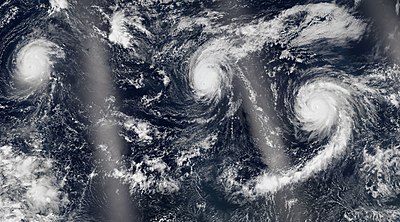
- 00:00 UTC (오후 2:00 HST, 8월 29일 오후 2시) 18°06˚N 175°42˚W / 18.1°N 175.7°W/ ( – 허리케인 Kilo는 존스턴 섬 서북서쪽 약 420 mi(675km)의 4등급 허리케인으로 더욱 강화된다.[5]
- 06:00 UTC(HST, 8월 29일 오후 8:00) 18°18°N 176°24°W / 18.3°N 176.4°W/ 4 (함 – 허리케인 Kilo는 존스턴 섬 서북서쪽 약 750km의 4등급 허리케인으로 최고 강도에 도달하며, 바람의 지속 속도는 220km/h이고 최소 압력은 940mbar(hPa; 27.76inHg)이다.[5]
- 06:00 UTC (8월 29일 오후 8:00 HST, 8월 29일 오후 8:00) 17°06˚N 147°42˚W / 17.1°N 147.7°W/ (함 – 동시에 허리케인 이그나시오는 시속 145mph의 바람과 942mbar(hPa; 27.82inHg), 하와이 힐로 동남동쪽 약 510mi(820km)의 중심기압으로 카테고리 4의 허리케인으로 최고 강도에 도달한다.[25]
- 18°54°N 177°36°W / 18.9 UTC(오전 8:00 HST)°N 177.6°W/ 6 약함 – 허리케인 킬로 약화는 존스턴 섬 서북서쪽 약 550mi(885km)의 3등급 허리케인으로 약화된다.[5]
- 18:00 UTC (오전 8:00 HST) 18°36′N 148°42′W / 18.6°N 148.7°W/ (됨 – 허리케인 이그나시오는 하와이 힐로에서 동쪽으로 425mi(685km) 떨어진 곳에서 카테고리 3으로 다시 약해진다.[25]
- 8월 31일
- 20°36°N 150°30°W / 20.6°N 150.5에서 12:00 UTC(오전 8:00 HST)°W/ 5로약화됨) – 허리케인 이그나시오는 하와이 힐로 북동쪽 약 305mi(490km)의 카테고리 2 허리케인으로 더욱 약해진다.[25]
- 11°48 utN 111°42′W / 11.8°N 111.7에서 18:00 UTC(MDT 오후 12:00)°W/ ( – 열대우울증 14-E는 멕시코 카보 산 루카스 남쪽 약 750 mi(1,205 km)의 기압이 긴 지역에서 발달한다.[27]
9월
- 9월 1일
- 22°3600N 152°36 31W / 22.6°N 152.6 august에서 06:00 UTC (오후 8월 31일 오후 8:00 HST, 8월 31일)°W/ (됨 – 허리케인 이그나시오는 하와이 힐로 북동쪽 약 255mi(410km)의 1등급 허리케인으로 더욱 약화된다.[25]
- 23°18°N 179°54°W / 23.3에서 12:00 UTC(오전 2:00 HST)°N 179.9°W/ (함 – 국제 날짜 표시선 동쪽에 있는 허리케인 Kilo의 마지막 기록 지점, 미드웨이 아톨에서 남서쪽으로 약 375 mi (605 km) 떨어져 있다.이후 6시간 이내에 킬로는 3등급 허리케인으로 국제 날짜 표시선을 넘어 서태평양 태풍이 된다.[5]
- 16°36에서 12:00 UTC(오전 5:00 PDT)′N 139°36′W / 16.6°N 139.6°W/ W / 6 ( 3 됨 – 카테고리 4 강도에 56시간을 소비한 후, 허리케인 Jimena는 카테고리 3의 상태가 하와이 힐로 남동동쪽 1,040mi(1,670km) 부근에 약해진다.얼마 지나지 않아 지메나는 140°W를 건너 중태평양 유역에 들어간다.[26]
- 18:00 UTC(MDT 오후 12:00) 13°06 113N 113°54′W / 13.1°N 113.9°W/ ( – 열대우울증 14-E는 멕시코 카보 산 루카스에서 남서쪽으로 약 725 mi (1,165 km) 떨어진 열대우림 케빈으로 강화된다.[27]
- 9월 2일
- 00:00 UTC (9월 1일 오후 2시, HST, 9월 1일 오후 2시) 24°12°N 155°00°W / 24.2°N 155.0°W/ (됨 – 허리케인 이그나시오는 하와이 호놀룰루 북동쪽 약 270 mi (435 km) 부근의 열대성 폭풍으로 분해된다.[25]
- 17°36에서 12:00 UTC(오전 2:00 HST)′N 142°24′W / 17.6°N 142.4°W/ 4 ( 2 됨 – 허리케인 Jimena는 하와이 힐로에서 동쪽으로 약 845 mi(1,355 km)[26] 떨어진 카테고리 2 허리케인으로 약화된다.
- 26°24°N 157°42°W / 26.4에서 18:00 UTC(오전 8:00 HST)°N 157.7°W/ ( 속으로)– 열대성 폭풍 이그나시오는 하와이 호놀룰루 북쪽 약 350mi(565km) 지점의 허리케인 1등급으로 복원된다.[25]
- 9월 3일
- 18:00 UTC(오전 8:00 HST) 29°06′N 162°06′W / 29.1°N 162.1°W/ 1 (됨 – 허리케인 이그나시오는 다시 한번 열대성 폭풍으로 약해져 하와이 호놀룰루 북서쪽 약 600mi(965km)[25]에 이른다.
- 18:00 UTC(오전 11:00 CDT) 18°30°N 115°48°W / 18.5°N 115.8°W/ ( 폭풍 함 – 열대성 폭풍 케빈은 멕시코 카보 산 루카스에서 남서쪽으로 약 485 mi (780 km)의 바람과 998 mbar (hPa; 29.47 inHg)의 압력으로 최고 강도에 도달한다.[27]
- 9월 4일
- UTC 06:00 (HST 오후 8:00, 9월 3일) 19°24′N 144°36′W / 19.4°N 144.6°W/ 6 ( 1 됨 – 허리케인 Jimena는 하와이 힐로에서 동쪽으로 약 685 mi(1,100 km) 떨어진 카테고리 1 상태로 떨어진다.[26]
- 9월 5일
- 00:00 UTC (9월 4일 오후 2시, HST, 9월 4일 오후 2시) 34°48˚N 164°24˚W / 34.8°N 164.4°W/ 4 (이) – 열대성 폭풍 이그나시오는 하와이 호놀룰루 북서쪽 약 1,005 mi (1,620 km) 부근의 열대성 저기압으로 변질된다.[25]
- 22°4에서 06:00 UTC(오전 12:00 MDT)8′N 114°36′W / 22.8°N 114.6°W/ 6 (됨 – 열대성 폭풍 케빈은 멕시코 카보 산 루카스에서 서쪽으로 약 300mi(485km) 떨어진 열대성 저기압으로 약화된다.[27]
- 23°12°N 114°18°W / 23.2°N 114.3에서 12:00 UTC(오전 6:00 MDT)°W/ 3 ( – 열대우울증 케빈은 멕시코 카보 산 루카스 서쪽 약 275 mi(445 km)의 낮은 잔류로 변질된다.[27]
- 18:00 UTC(오전 8:00 HST) 21°30˚N 146°30˚W / 21.5°N 146.5°W/ 됨 – 허리케인 히메나는 하와이 힐로에서 북동쪽으로 570m(915km) 정도 떨어진 열대성 폭풍으로 분해된다.[26]
- 12°06에서 18:00 UTC(MDT 오후 12:00)′N 106°18′W / 12.1°N 106.3°W/ ( – 열대우울증 15-E는 멕시코 만자니요에서 남서쪽으로 약 490 mi (790 km) 떨어진 곳에 잘 정의된 낮은 곳에서 발달한다.[28]
- 9월 6일
- 13°12′N 107°48에서 06:00 UTC(오전 12:00 MDT)′W / 13.2°N 107.8°W/ ( – 열대우울증 15-E는 멕시코 만자니요 남서쪽 약 520 mi(835 km)의 열대성 폭풍 린다로 강화된다.[28]
- 9월 7일
- 06:00 UTC (오전 12:00 MDT) 16°18′N 111°00′W / 16.3°N 111.0°W/ ;0 (됨 – 열대성 폭풍 린다는 소코로 섬 남쪽 약 165 mi (265km)의 범주 1 허리케인 상태에 도달한다.[28]
- 17°12°N 111°42°W / 17.2°N 111.7에서 12:00 UTC(오전 6:00 MDT)°W/ (함 – 허리케인 린다는 소코로 섬의 남남서남서쪽 약 115mi(185km)의 카테고리 2로 강화된다.[28]
- 9월 8일
- 20°36 utN 113°36:W/20.6°N 113.6W함에서 12:00 UTC(오전 6:00 MDT) – 허리케인 린다는 소코로섬 북서쪽 약 210 mi(340km)의 카테고리 3으로 강화된다.풍속 205km/h(125mph), 압력 950mbar(hPa; 28.05inHg)로 동시에 최고 강도에 도달한다.[28]
- 9월 9일
- UTC 06:00 (PDT, 9월 8일 오후 11:00) 22°48′N 115°54′W / 22.8°N 115.9°W/ (됨 – 허리케인 린다는 카테고리 2로 낮아져 멕시코 카보 산 루카스에서 서쪽으로 약 385 mi(620 km) 떨어진 더 차가운 물 위로 급속한 약화 단계로 진입한다.[28]
- 25°30°N 155°12°W / 25.5°N 155.2에서 12:00 UTC(오전 2:00 HST)°/ ;2 (됨 – 열대성 폭풍 히메나는 하와이 호놀룰루 북동쪽 약 335 mi(540 km)의 열대성 저기압으로 약화된다.[26]
- 23°24 utN 116°24:W / 23.4에서 12:00 UTC(오전 5:00 PDT)°N 116.4°W/ (됨 – 허리케인 린다는 멕시코 카보 산 루카스 서북서쪽 약 415 mi(670 km)의 카테고리 1 허리케인으로 약화된다.[28]
- 18:00 UTC (11:00 a.m. PDT) at 24°00′N 117°00′W / 24.0°N 117.0°W – Hurricane Linda weakens to a tropical storm about 455 mi (730 km) west-northwest of Cabo San Lucas, Mexico.[28]
- 9월 10일
- 00:00 UTC (HST 오후 2시, 9월 9일) 24°42′N 156°48′W / 24.7°N 156.8°W/ 8 ( – 열대우림 지메나는 하와이 호놀룰루 북북동쪽 약 230 mi(370 km)의 낮은 잔존으로 변질된다.[26]
- 25°4에서 12:00 UTC(오전 5:00 PDT)2′N 118°24′W / 25.7°N 118.4°W/ 4 (됨)– 열대성 폭풍 린다는 멕시코 카보 산 루카스 북서쪽 약 570 mi(915 km)의 낮은 수준으로 변질된다.[28]
- 9월 18일
- 18:00 UTC (8:00 a.m. HST) at 17°12′N 176°00′W / 17.2°N 176.0°W – Tropical Depression Five-C develops roughly 1,210 mi (1,945 km) west-southwest of Honolulu, Hawaii.[29]
- 9월 20일
- 24°18 utN 113°42′W / 24.3에서 18:00 UTC(MDT 오후 12:00)°N 113.7°W/ 7 ( – 열대우울증 16-E는 멕시코 산 카를로스 서남서쪽 약 105 mi (170 km)를 형성한다.[30]
- 9월 21일
- 00:00 UTC (오후 2:00 HST, 9월 20일) 23°06˚N 172°30˚W / 23.1°N 172.5°W/ ( – 열대우울증 5-C는 하와이 레이산에서 남쪽으로 약 190 mi(305km) 떨어진 열대우림 말리아로 강화된다.[29]
- 04:45 UTC (10:45 p.m. MDT, September 20) at 26°36′N 113°06′W / 26.6°N 113.1°W – Tropical Depression Sixteen-E makes its first landfall near Punta Abreojos in Baja California Sur, with winds of 35 mph (55 km/h) and a minimum pressure of 1001 mbar (hPa; 29.56 inHg).[30]
- 25°12°N 171°24°W / 25.2에서 12:00 UTC(오전 2:00 HST)°N 171.4°W/ 4 ( 폭풍 에 도달함 – 열대성 폭풍 말리아는 시속 85km의 바람과 992mbar (hPa; 29.29inHg)의 압력으로 하와이 레이산 남동쪽 약 45mi (70km)의 최고 강도에 도달한다.[29]
- 13:45 UTC(오전 7:45 MDT) 28°48 atN 112°18′W / 28.8°N 112.3°W/ (함 – 열대우울증 16-E는 소노라의 이슬라 티부론 근처에 두 번째 상륙하며, 바람은 55km/h(35mph), 최소 압력은 1002mbar(HPa; 29.59)이다.[30]
- 15:00 UTC (9:00 a.m. MDT) at 29°12′N 112°12′W / 29.2°N 112.2°W – Tropical Depression Sixteen-E makes its third landfall near Punta Chueca in Sonora, with winds of 35 mph (55 km/h) and a minimum pressure of 1003 mbar (hPa; 29.62 inHg).[30]
- 18:00 UTC(MDT 오후 12:00) – 열대성 저기압 16-E는 소노라 상공에서 소멸하지만, 소노라의 잔해가 북동쪽으로 계속 이동하고 나중에 미국 남서부로 유입된다.[30]
- 9월 22일
- 18:00 UTC (오전 8:00 HST) 29°18′N 173°18′W / 29.3°N 173.3°W/ ( 폭풍 – 열대성 폭풍 말리아는 하와이 레이산 북서쪽 약 260 mi(420 km)의 낮은 잔해로 변질된다.[29]
- 9월 25일
- 00:00 UTC (오후 2:00 HST, 9월 24일 오후 2시) 149°06°W / 14.0°N 149.1°W/ 1 ( – 열대우울증 6-C는 하와이 힐로 남동쪽 약 560mi (900km) 지점에 발달한다.[31]
- UTC 06:00 (HST 오후 8:00, 9월 24일) 14°24′N 149°24′W / 14.4°N 149.4°W/ 4 (가 됨 – 열대우울증 6-C는 하와이 힐로 남동쪽 약 525 mi(845 km)의 열대우림 니알라로 강화된다.[31]
- 9월 26일
- 18:00 UTC (오전 8:00 HST) 17°06′N 151°54′W / 17.1°N 151.9°W/ ( 폭풍 에도달함) – 열대성 폭풍 니알라는 시속 65mph의 바람과 992mbar(hPa; 29.29inHg)의 압력으로 하와이 힐로 남동쪽 약 275mi(445km)의 최대 강도에 도달한다.[31]
- 18:00 UTC(오후 1:00 UTC. 오후 1시 CDT) 13°066N 103°0000W / 13.1°N 103.0°W/ – 열대우울증 17-E는 멕시코 아카풀코 남서쪽 약 335mi(540km)의 열대파로부터 형성된다.[32]
- 9월 27일
- 00:00 UTC (9월 26일 오후 7시 CDT, 9월 26일) 13°36′N 103°06′W / 13.6°N 103.1°W/ ( – 열대우울증 세븐틴-E는 멕시코 아카풀코 남서쪽 약 310mi (500km)의 열대우림 마티로 발전한다.[32]
- 9월 28일
- 15°00 utN 156°36′W / 15.0°N 156.6에서 12:00 UTC(오전 2:00 HST)°W/ ( 폭풍 됨 – 열대성 폭풍 니알라는 하와이 호놀룰루 남쪽 약 440 mi(710km) 부근의 열대성 저기압으로 약화된다.[31]
- 16°18에서 12:00 UTC(오전 7:00 CDT)′N 103°00′W / 16.3°N 103.0°W/ 0 – 열대성 폭풍 마티는 멕시코 아카풀코 서쪽 약 220mi(355km) 부근의 1등급 허리케인이 된다.[32]
- 16°36에서 18:00 UTC(오후 1:00 CDT)′N 102°24′W / 16.6°N 102.4°W/ ( – 허리케인 마티는 멕시코 아카풀코 서쪽에서 약 170 mi(275 km)의 최고 강도에 도달하여 130 km/h의 지속적인 바람과 987 mbar(Hpa; 29.15 InHg)의 중심 압력을 가지고 있다.[32]
- 9월 29일
- 00:00 UTC (HST 오후 2시, 9월 28일) 15°24′N 158°24′W / 15.4°N 158.4°W/ ( – 열대우림 니알라는 하와이 호놀룰루 남쪽 약 410 mi(660 km)의 낮은 잔해로 변한다.[31]
- 16°18에서 06:00 UTC(오전 1:00 CDT)′N 101°54′W / 16.3°N 101.9°W/ ( 마티는 됨) – 허리케인 마티는 멕시코 아카풀코 서남서쪽 약 140 mi(225 km)의 열대성 폭풍으로 다시 약해진다[32]
- 9월 30일
- 16°06에서 06:00 UTC(오전 1:00 CDT)′N 101°42인치W / 16.1°N 101.7°W/ ( 폭풍 후 됨 – 열대성 폭풍 마티는 멕시코 아카풀코 서남서쪽 약 130 mi(210 km)의 열대성 후 사이클론으로 변질된다.[32]
10월
- 10월 3일
- 06:00 UTC (10월 2일 오후 8:00 HST, 10월 2일 오후 8:00) 12°30°N 155°24°W / 12.5°N 155.4°W/ ( – 열대우울증 7-C는 하와이 카래 남쪽 약 445 mi(715 km)에서 발달한다.[33]2015년 12번째 열대성 저기압은 중부 태평양으로 형성되거나, 이는 위성 시대 분지 내 가장 많은 시스템 수를 나타낸다.[34]
- 06:00 UTC (10월 2일 오후 8:00 HST, 10월 2일 오후 8:00) 12°18 octoberN 171°30:W / 12.3°N 171.5°W/ ( – 열대우울증 8-C는 존스턴 섬 남남서쪽 약 335 mi (540 km)에 이른다.55km/h(35mph)의 바람과 1001mbar(hPa; 29.56inHg)의 압력으로 동시에 최고 강도에 도달한다.[35]
- 12°36′N 155°12′W / 12.6°N 155.2에서 12:00 UTC(오전 2:00 HST)°W/ ( – 열대우울증 7-C는 하와이 카래에서 남쪽으로 약 435 mi (700 km) 떨어진 열대우림 오호로 강화된다.[33]
- 10월 4일
- UTC 06:00 (HST 오후 8:00, 10월 3일) 10°42′N 171°36′W / 10.7°N 171.6°W/ ( – 열대우울증 8-C는 존스턴 섬 남남서쪽 약 440 mi (710 km)의 열대저압부로 변질된다.[35]
- 10월 6일
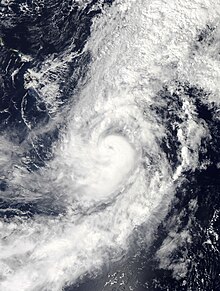
- 15°06°N 151°54°W / 15.1°N 151.9에서 12:00 UTC(오전 2:00 HST)°W/ (함 – 열대성 폭풍 오호는 하와이 힐로 남동쪽 약 380mi(610km) 부근의 허리케인으로 강화된다.[33]
- 10월 7일
- UTC 06:00 (HST 오후 8:00, 10월 6일) 19°06′N 147°54′W / 19.1°N 147.9°W/ 함 – 허리케인 오호는 하와이 힐로에서 동쪽으로 약 470mi(755km) 떨어진 카테고리 2에 도달한다.[33]
- 21°54°N 146°36°W / 21.9에서 12:00 UTC(오전 2:00 HST)°N 146.6°W/ 6 (함 – 허리케인 오호는 하와이 힐로 동북동쪽 약 570 mi (915 km)의 풍속 175 km/h의 풍속과 957 mbar (hPa; 28.26 inHg)의 압력으로 최고 강도에 도달한다.[33]
- 10월 8일
- 00:00 UTC (10월 7일 오후 2:00 HST, 10월 7일 오후 2시) 28°48°N 145°12°W / 28.8°N 145.2°W/ (됨 – 허리케인 오호는 하와이 힐로 북동쪽 약 885mi(1,425km)의 카테고리 1로 약화된다.[33]
- 12:00 UTC(오전 2:00 HST) 33°18′N 142°30′W / 33.3°N 142.5°W/ 5 ( – 허리케인 오호는 하와이 힐로 북동쪽 약 1,220 mi (1,960 km)의 허리케인 힘 아래로 바람이 떨어지는 아열대성 사이클론으로 전환한다.[33]
- 10월 9일
- 10°48에서 12:00 UTC(오전 5:00 PDT)′N 131°36′W / 10.8°N 131.6°W/ ( – 열대우울증 18-E는 하와이 힐로 남동쪽 약 1,680 mi(2,705 km)의 저기압의 넓은 지역에서 발달한다.[36]
- 10월 10일
- 00:00 UTC (5:00 p.m. PDT, October 9) at 11°06′N 134°30′W / 11.1°N 134.5°W – Tropical Depression Eighteen-E strengthens into Tropical Storm Nora roughly 1,495 mi (2,405 km) southeast of Hilo, Hawaii.[36]
- 10월 11일
- 06:00 UTC (오후 8:00 HST, 10월 10일 오후 8:00) – 열대성 폭풍 노라가 140°W의 서부를 가로질러 중앙 태평양 유역에 들어간다.[36]
- 10월 12일
- 00:00 UTC (10월 11일 오후 2:00 HST, 10월 11일 오후 2시) 12°18°N 143°30°W / 12.3°N 143.5°W/ (함 – 열대성 폭풍 노라는 하와이 힐로 남동쪽 약 925 mi(1,490 km)의 약 110 km/h의 바람과 993 mbar (hPa; 29.32 inHg)의 압력으로 최고 강도에 도달한다.[36]
- 10월 14일
- 06:00 UTC(HST, 10월 13일 오후 8:00) 14°48˚N 150°24′W / 14.8°N 150.4°W/ (됨 – 열대성 폭풍 노라는 하와이 힐로 남동쪽 약 460mi(740km)의 열대성 우울증으로 약화된다.[36]
- 10월 15일
- 00:00 UTC (6:00 p.m. MDT, October 14) at 10°12′N 117°00′W / 10.2°N 117.0°W – Tropical Depression Nineteen-E forms from a broad area of low pressure around 990 mi (1,595 km) south-southwest of Cabo San Lucas, Mexico.[37]
- 18:00 UTC(오전 8:00 HST) 16°36 152N 152°42 utW / 16.6°N 152.7°W/ ( – 열대우울증 노라는 하와이 힐로 남동쪽 약 265 mi (425 km)의 낮은 잔존으로 변한다.[36]
- 10월 17일
- 00:00 UTC (10월 16일 오후 5:00 PDT, 10월 16일) 9°24 atN 126°48′W / 9.4°N 126.8°W/ ( – 열대우림 19-E는 바하 캘리포니아 반도의 남쪽 끝에서 남서쪽으로 약 1,455 mi (2,340 km) 떨어진 열대우림 올라프로 강화된다.[37]
- 10월 18일
- 06:00 UTC(오후 11:00 PDT, 10월 17일) 9°18)N 131°36′W / 9.3°N 131.6°W/ (이 됨 – 열대성 폭풍 올라프가 바하 캘리포니아 반도의 남서쪽 약 1,715 mi(2,760 km)의 1등급 허리케인으로 강화되어 동태평양에서 기록적으로 가장 낮은 등급의 허리케인이 된다.[37]
- 10월 19일
- 00:00 UTC (5:00 p.m. PDT, October 18) at 9°36′N 135°00′W / 9.6°N 135.0°W – Hurricane Olaf intensifies into a Category 2 hurricane about 1,895 mi (3,050 km) west-southwest of the southern tip of the Baja California Peninsula.[37]
- 12:00 UTC (5:00 a.m. PDT) at 9°48′N 137°12′W / 9.8°N 137.2°W – Hurricane Olaf rapidly strengthens into a Category 3 hurricane approximately 2,015 mi (3,245 km) west-southwest of the southern tip of the Baja California Peninsula.이것은 올라프가 동태평양에서 기록되어 있는 가장 낮은 위도의 허리케인이라는 것을 더욱 더 구별하게 한다.[37]
- 18:00 UTC(오전 11:00 PDT) 9°54′N 138°12′W / 9.9°N 138.2°W/ 9W / 2 (4함 – 허리케인 Olaf는 캘리포니아 반도의 남단에서 서남서쪽으로 2,070mi(3,335km) 정도 떨어진 카테고리 4 허리케인으로 급속히 강화된다.[37]
- 10월 20일
- UTC 06:00 (HST 오후 8:00, 10월 19일) 10°12′N 140°00′W / 10.2°N 140.0°W – Hurricane Olaf crosses into the Central Pacific basin and concurrently reaches peak intensity with winds of 150 mph (240 km/h) and a minimum pressure of 938 mbar (hPa; 27.70 inHg), while located about 1,200 mi (1,935 km) east-southeast of Hilo, Hawaii.[37]
- 13°24에서 06:00 UTC(오전 1:00 CDT)′N 94°00′W / 13.4°N 94.0°W/ ( – 열대우울증 20-E는 멕시코 살리나 크루즈에서 남동쪽으로 약 205mi(330km) 정도 발전한다.[38]
- 10월 21일
- 00:00 UTC(오후 7:00 UTC, 10월 20일 오후 CDT) 13°06˚N 95°06˚W / 13.1°N 95.1°W/ ( – 열대우울증 20E는 멕시코 살리나 크루즈에서 남쪽으로 약 215 mi(345 km) 떨어진 열대성 폭풍 패트리샤로 강화된다.[38]
- 12:00 UTC (2:00 a.m. HST) at 11°36′N 144°06′W / 11.6°N 144.1°W – Hurricane Olaf weakens to Category 3 status around 920 mi (1,480 km) southeast of Hilo, Hawaii.[37]
- 10월 22일
- 14°00˚N 101°4에서 06:00 UTC(오전 1:00 CDT)2㎛W / 14.0°N 101.7°W/ 7 (됨 – 열대성 폭풍 패트리샤는 멕시코 아카풀코 남서쪽 약 230mi(370km)의 카테고리 1 허리케인 상태에 도달한다.[38]
- 14°36에서 12:00 UTC(오전 7:00 CDT)′N 103°06′W / 14.6°N 103.1°W/ (함) – 허리케인 Patricia는 멕시코 만사니요에서 남쪽으로 약 315 mi(505 km) 떨어진 카테고리 2로 빠르게 강화된다[38]
- 18:00 UTC(오전 8:00 HST) 13°30°N 146°18°W / 13.5°N 146.3°W/ 3 ( 2 됨 – 허리케인 Olaf는 하와이 힐로 남동쪽 약 725 mi(1,165 km)의 카테고리 2 상태로 잠시 약해진다.[37]
- 18:00 UTC(오후 1:00 UTC. 오후 1:00 CDT) 15°12nN 104°12′W / 15.2°N 104.2°W/ 2 (함 – 허리케인 Patricia는 멕시코 만사니요에서 남쪽으로 약 265 mi (425 km) 떨어진 카테고리 4의 상태로 폭발적으로 강화된다.[38]
- 10월 23일

- 00:00 UTC (10월 22일 오후 2:00 HST, 10월 22일 오후 2:00) 146°18°W / 14.0°N 146.3°W/ (함 – 허리케인 Olaf는 하와이 힐로 남동쪽 약 700mi(1,130km)의 카테고리 3의 강도를 재장착한다.[37]
- 00:00 UTC(오후 7:00 CDT, 10월 22일) 15°48′N 104°54′W / 15.8°N 104.9°W/ 함 – 허리케인 패트리샤는 폭발적으로 강해져 멕시코 만자니요에서 남서쪽으로 약 225mi(360km) 떨어진 카테고리 5에 도달한다.[38]
- 17°18°N 105°36°W / 17.3에서 12:00 UTC(오전 7:00 CDT)°N 105.6°W/ 6 (함 – 허리케인 Patricia는 멕시코 만사니요 남서쪽 약 150 mi (240 km)의 바람 (345 km/h)과 872 mbar (hPa; 25.75 inHg)의 압력으로 최고 강도에 도달한다.이는 파트리샤를 882mbar(hPa; 26.05inHg)의 압력을 얻은 2005년 대서양 허리케인 윌마를 제치고 서반구에서 관측된 열대 저기압 중 가장 강력한 열대 저기압으로 분류한다.이 사이클론은 또한 1979년 870mbar(hPa; 25.69inHg)의 압력을 받은 태풍 팁을 제외하면 세계에서 두 번째로 강력한 열대성 사이클론이다.[38]
- 19°24에서 UTC 23:00(오후 6:00 CDT)′N 105°00′W / 19.4°N 105.0°W/ (한다 – 허리케인 Patricia는 시속 240km의 바람과 932mbar(Hg; 27.52inHg)의 압력으로 4등급 허리케인으로 급격히 약화되어 멕시코 쿠익스말라 부근에 상륙한다.이것은 동태평양에서 기록된 가장 강력한 상륙 폭풍이 된다.[38]
- 10월 24일
- 00:00 UTC (10월 23일 오후 7시 CDT, 10월 23일) 19°36′N 104°54′W / 19.6°N 104.9°W/ 됨 – 허리케인 패트리샤는 멕시코 만자니요 북북서쪽 약 85mi(135km)의 카테고리 3으로 약화된다.
- 03:00 UTC(오후 10:00 CDT, 10월 23일 오후 10:00) 20°12°N 104°36′W / 20.2°N 104.6°W/ (됨 – 허리케인 패트리샤는 멕시코 과달라하라 서남서쪽 약 85 mi (135 km)의 열대성 폭풍으로 급속히 약화된다.[38][39]
- 23°12°N 102°18°W / 23.2에서 12:00 UTC(오전 7:00 CDT)°N 102.3°W/ 3 ( 폭풍 됨 – 열대성 폭풍 패트리샤는 멕시코 아구아스칼리엔테스 시에서 북쪽으로 약 90m(145km) 떨어진 열대성 저기압으로 약화된다.[38]
- 18:00 UTC (오후 1:00 CDT) – Patricia는 멕시코 중부 상공에서 소멸한다.[38]
- 19°42에서 18:00 UTC(오전 8:00 HST)′N 145°06′W / 19.7°N 145.1°W/ ( 2 됨 – 허리케인 Olaf는 하와이 힐로에서 동쪽으로 약 650mi(1,045km) 떨어진 카테고리 2로 다시 약해진다.[37]
- 10월 25일
- 20°48에서 06:00 UTC(HST, 10월 24일 오후 8:00)′N 144°12′W / 20.8°N 144.2°W/ – 허리케인 Olaf는 하와이 힐로에서 동쪽으로 약 710mi(1,140km) 떨어진 카테고리 1의 강도로 더욱 약해진다.[37]
- 10월 26일
- 24°24°N 141°30°W / 24.4에서 12:00 UTC(오전 2:00 HST)°N 141.5°W/ 5 (됨) 허리케인 Olaf는 캘리포니아 샌디에이고 서남서쪽 약 1,580 mi (2,545 km)의 열대성 폭풍으로 약화된다.[37]
- 25°18°N 139°30°W / 25.3에서 18:00 UTC(오전 8:00 HST)°N 139.5°W/ 5 진입함 – 열대성 폭풍 올라프가 서쪽에서 140°W를 가로지르며 캘리포니아 샌디에이고 서남서쪽 약 1,440mi(2,320km)의 동태평양 유역에 다시 진입한다.이로써 올라프는 동태평양에서 중태평양으로 건너가 다시 동태평양으로 돌아온 최초의 열대성 사이클론이 되었다.[37]
- 10월 27일
- 12:00 UTC(오전 2:00 HST) 26°36′N 135°30′W / 26.6°N 135.5°W/ ( 후기)– 열대성 폭풍 올라프는 캘리포니아 샌디에이고 서남서쪽 약 1,180 mi (1,900 km)의 열대성 후기 사이클론으로 변질된다.[37]
11월
- 11월 18일
- 12:00 UTC(MST 오전 5:00) 12°54′N 106°54′W / 12.9°N 106.9°W/ ( – 열대우울증 211-E는 멕시코 만사니요에서 남서쪽으로 약 455 mi (730 km) 떨어져 있다.[40]
- 11월 19일
- 14°12°N 106°06°W / 14.2°N 106.1에서 12:00 UTC(오전 5:00 MST)°W/ 1 ( – 열대우울증 21-E는 멕시코 만자니요에서 남서쪽으로 약 355 mi (570 km) 떨어진 열대우림 릭으로 강화된다.65km/h의 바람과 1002mbar(hPa; 29.59inHg)의 압력으로 동시에 최고 강도에 도달한다.[40]
- 11월 22일
- 06:00 UTC (10:00 p.m. PST, November 21) at 17°00′N 117°30′W / 17.0°N 117.5°W – Tropical Storm Rick weakens to a tropical depression roughly 640 mi (1,030 km) southwest of Cabo San Lucas, Mexico.[40]
- 18:00 UTC(태평양 표준시 오전 10:00) 17°48 118N 118°54′W / 17.8°N 118.9°W/ ( – 열대우울증은 멕시코 카보 산 루카스에서 남서쪽으로 약 675 mi (1,085 km) 떨어진 낮은 잔류로 변질된다.[40]
- 11월 23일
- 10°48에서 18:00 UTC(CST 오후 12:00)′N 102°00′W / 10.8°N 102.0°W/ – 열대우울증 22-E는 멕시코 아카풀코 남서쪽 약 440mi(710km)를 형성한다.[41]
- 11월 24일
- 00:00 UTC(CST 오후 6시, 11월 23일) 10°48′N 103°18′W / 10.8°N 103.3°W/ ( – 열대우울증 22-E는 멕시코 만자니요에서 남쪽으로 약 575 mi(925 km) 떨어진 열대우산드라로 강화된다.[41]
- 11월 25일
- 06:00 UTC(MST 오후 11:00, 11월 24일) 12°06′N 108°30′W / 12.1°N 108.5°W/ 됨 – 열대성 폭풍 산드라는 멕시코 만자니요에서 남서쪽으로 약 555mi(895km) 떨어진 범주 1 허리케인으로 강화된다.[41]
- 12:00 UTC(MST 오전 5:00) 12°18′N 109°18′W / 12.3°N 109.3°W/ 3 (함 – 허리케인 산드라는 멕시코 만자니요에서 남서쪽으로 약 570 mi(915 km) 떨어진 카테고리 2 허리케인으로 빠르게 강화된다.[41]
- 11월 26일
- 00:00 UTC (5:00 p.m. MST, November 25) at 13°18′N 110°12′W / 13.3°N 110.2°W – Hurricane Sandra reaches Category 3 status roughly 555 mi (895 km) southwest of Manzanillo, Mexico, becoming the latest-forming major hurricane in the Northeastern Pacific on record.[41]
- 06:00 UTC (11:00 p.m. MST, November 25) at 14°06′N 110°12′W / 14.1°N 110.2°W – Hurricane Sandra rapidly strengthens into a Category 4 hurricane about 530 mi (855 km) southwest of Cabo Corrientes, Mexico.시속 150mph의 바람과 934mbar(hPa; 27.58inHg)의 압력으로 동시에 최고 강도에 도달한다.[41]
- 11월 27일
- 00:00 UTC (MST, 11월 26일 오후 5시) 17°24′N 109°48′W / 17.4°N 109.8°W/ 8됨 – 허리케인 산드라는 카테고리 3의 허리케인으로 약해져 바하 캘리포니아 반도의 남쪽 끝에서 약 380mi(610km) 남쪽에 있다.[41]
- 06:00 UTC(MST, 11월 26일 오후 11:00) 18°30°N 109°18°W/18.5°N 109.3°W/ (됨 – 허리케인 산드라는 바하 캘리포니아 반도의 남쪽 끝에서 약 305 mi (490 km) 떨어진 카테고리 2 허리케인으로 급속히 약화된다.[41]
- 20°00′N 108°12′W / 20.0에서 18:00 UTC(오전 11:00 MST)°N 108.2°W/ 됨 – 허리케인 산드라는 이스라 마리아스에서 남서쪽으로 약 150mi(240km) 떨어진 카테고리 1 허리케인으로 약화된다.[10]
- 11월 28일
- 00:00 UTC(MST 오후 5시, 11월 27일) 20°42′N 108°48′W / 20.7°N 108.8°W/ 8 ( 약화됨 – 허리케인 산드라는 이슬라스 마리아스에서 남서쪽으로 약 160 mi(255 km) 떨어진 열대성 폭풍으로 급속히 약화된다.[41]
- 21°12°N 109°06°W / 21.2에서 06:00 UTC(MST, 11월 27일 오후 11:00)°N 109.1°W/ (됨 – 열대성 폭풍 산드라는 멕시코 카보 산 루카스에서 북동쪽으로 약 125 mi (200 km) 떨어진 낮은 잔류로 변질된다.[41]
- 11월 30일
- 2015년 태평양 허리케인 시즌이 공식적으로 끝난다.[2]
12월
- 12월 31일
- 00:00 UTC (12월 30일 오후 2:00 HST, 12월 30일 오후 2시) 2°12°N 175°30°W / 2.2°N 175.5°W/ 2( – 열대우울증 9-C는 존스턴 섬 남남서쪽 약 1,080 mi (1,740 km)에 발달한다.동시에, 55 km/h의 바람과 1001 mbar의 최소 압력(hPa; 29.56 inHg)으로 우울증은 최고 강도에 도달한다.[42]
2016년 1월
- 1월 1일
- 00:00 UTC (12월 31일 오후 2:00 HST, 12월 31일 오후 2시) 2°12°N 176°24°W / 2.2°N 176.4°W/ 24 ( – 열대우울증 9-C는 존스턴 섬 남남서쪽 약 1,105 mi (1,780 km)의 낮은 수준으로 약해진다.[42]
참고 항목
메모들
참조
- ^ Kieran Hickey (August 2016). "A review of the 2015 hurricane, tropical cyclone and typhoon season". International Journal of Meteorology. 41 (398): 162–167. Retrieved March 3, 2019.
- ^ a b c Neal Dorst (June 2, 2016). "TCFAQ G1) When is hurricane season?". Atlantic Oceanographic and Meteorological Laboratory. Archived from the original on May 5, 2009. Retrieved July 24, 2018.
- ^ Stan Goldenberg (June 1, 2017). "TCFAQ A3) What is a super-typhoon? What is a major hurricane? What is an intense hurricane?". Atlantic Oceanographic and Meteorological Laboratory. Archived from the original on April 26, 2014. Retrieved May 24, 2018.
- ^ Tropical Weather Summary for the Central North Pacific (Report). Honolulu, Hawaii: Central Pacific Hurricane Center. January 1, 2016. Archived from the original on April 2, 2019. Retrieved March 2, 2019.
- ^ a b c d e f g h i j Thomas Birchard (October 10, 2018). Hurricane Kilo (PDF) (Report). Tropical Cyclone Report. Honolulu, Hawaii: Central Pacific Hurricane Center. Retrieved June 9, 2019.
- ^ Lixion A. Avila (February 26, 2016). 2015 Eastern North Pacific Hurricane Season (PDF) (Report). Annual Summary. Miami, Florida: National Hurricane Center. Retrieved March 2, 2019.
- ^ Chris Brenchley (December 18, 2015). Historic Hurricane Season – 2015 Summary for the Central Pacific Basin (PDF) (Report). Honolulu, Hawaii: Central Pacific Hurricane Center. Archived from the original (PDF) on April 2, 2019. Retrieved March 2, 2019.
- ^ Robbie Berg (May 28, 2015). Tropical Depression One-E Discussion Number 1 (Report). Miami, Florida: National Hurricane Center. Retrieved June 27, 2015.
- ^ "About the Central Pacific Hurricane Center". National Oceanographic and Atmospheric Administration. Retrieved August 18, 2019.
- ^ a b c d e f g h i j k l m Michael J. Brennan (August 6, 2015). Hurricane Andres (PDF) (Report). Tropical Cyclone Report. Miami, Florida: National Hurricane Center. Retrieved December 6, 2015.
- ^ a b c d e f g h i j k l m n o p q r s t Richard J. Pasch & David P. Roberts (November 30, 2015). Hurricane Blanca (PDF) (Report). Tropical Cyclone Report. Miami, Florida: National Hurricane Center. Retrieved December 8, 2015.
- ^ a b Jeff Masters (June 8, 2015). "Tropical Storm Blanca Hits Baja a Month Earlier Than Their Previous Earliest Landfall". Weather Underground. Retrieved September 25, 2019.
- ^ a b c d e f g h i j John L. Beven II & Christopher W. Landsea (October 27, 2015). Hurricane Carlos (PDF) (Report). Tropical Cyclone Report. Miami, Florida: National Hurricane Center. Retrieved December 8, 2015.
- ^ a b c d e Stacy R. Stewart; Thomas Birchard (October 17, 2016). Tropical Storm Ela (PDF) (Report). Tropical Cyclone Report. Honolulu, Hawaii: Central Pacific Hurricane Center. Retrieved November 20, 2016.
- ^ a b c d Derek Wroe (July 9, 2017). Tropical Storm Halola (PDF) (Report). Tropical Cyclone Report. Honolulu, Hawaii: Central Pacific Hurricane Center. Retrieved June 9, 2019.
- ^ a b c d Christopher Jacobson (April 16, 2018). Tropical Storm Iune (PDF) (Report). Tropical Cyclone Report. Honolulu, Hawaii: Central Pacific Hurricane Center. Retrieved June 9, 2019.
- ^ a b c d e f g h i j Todd B. Kimberlain (October 27, 2015). Hurricane Dolores (PDF) (Report). Tropical Cyclone Report. Miami, Florida: National Hurricane Center. Retrieved December 8, 2015.
- ^ a b c d e Daniel P. Brown (September 16, 2015). Tropical Storm Enrique (PDF) (Report). Tropical Cyclone Report. Miami, Florida: National Hurricane Center. Retrieved December 8, 2015.
- ^ a b c d John P. Cangialosi (September 3, 2015). Tropical Storm Felicia (PDF) (Report). Tropical Cyclone Report. Miami, Florida: National Hurricane Center. Retrieved December 8, 2015.
- ^ a b Robbie Berg (September 9, 2015). Tropical Depression Eight-E (PDF) (Report). Tropical Cyclone Report. Miami, Florida: National Hurricane Center. Retrieved December 9, 2015.
- ^ a b c d e f g h i j Lixion A. Avila (September 29, 2015). Hurricane Guillermo (PDF) (Report). Tropical Cyclone Report. Miami, Florida: National Hurricane Center. Retrieved December 8, 2015.
- ^ a b c d e f g h i j k l Eric S. Blake (October 29, 2015). Hurricane Hilda (PDF) (Report). Tropical Cyclone Report. Miami, Florida: National Hurricane Center. Retrieved December 9, 2015.
- ^ a b Richard J. Pasch (February 16, 2016). Tropical Depression Eleven-E (PDF) (Report). Tropical Cyclone Report. Miami, Florida: National Hurricane Center. Retrieved February 27, 2016.
- ^ a b c d e f g h Derek Wroe (August 1, 2017). Hurricane Loke (PDF) (Report). Tropical Cyclone Report. Honolulu, Hawaii: Central Pacific Hurricane Center. Retrieved June 9, 2019.
- ^ a b c d e f g h i j k l m n John L. Beven II; Christopher Jacobson (August 17, 2018). Hurricane Ignacio (PDF) (Report). Tropical Cyclone Report. Miami, Florida and Honolulu, Hawaii: National Hurricane Center. Retrieved August 21, 2018.
- ^ a b c d e f g h i j k l Stacy R. Stewart; Jeffrey Powell (February 4, 2016). Hurricane Jimena (PDF) (Report). Tropical Cyclone Report. Miami, Florida: National Hurricane Center. Retrieved February 9, 2016.
- ^ a b c d e Todd B. Kimberlain (November 28, 2015). Tropical Storm Kevin (PDF) (Report). Tropical Cyclone Report. Miami, Florida: National Hurricane Center. Retrieved December 9, 2015.
- ^ a b c d e f g h i Daniel P. Brown (November 12, 2015). Hurricane Linda (PDF) (Report). Tropical Cyclone Report. Miami, Florida: National Hurricane Center. Retrieved December 9, 2015.
- ^ a b c d Jon Jelsema (June 1, 2016). Tropical Storm Malia (PDF) (Report). Tropical Cyclone Report. Honolulu, Hawaii: Central Pacific Hurricane Center. Archived from the original (PDF) on June 20, 2018. Retrieved June 20, 2018.
- ^ a b c d e John P. Cangialosi (January 11, 2016). Tropical Depression Sixteen-E (PDF) (Report). Tropical Cyclone Report. Miami, Florida: National Hurricane Center. Retrieved January 14, 2016.
- ^ a b c d e Sam Houston; Thomas Birchard (November 16, 2016). Tropical Storm Niala (Report). Tropical Cyclone Report. Honolulu, Hawaii: Central Pacific Hurricane Center. Archived from the original on February 4, 2019. Retrieved January 8, 2017.
- ^ a b c d e f Robbie Berg (January 5, 2016). Hurricane Marty (PDF) (Report). Tropical Cyclone Report. Miami, Florida: National Hurricane Center. Retrieved January 15, 2016.
- ^ a b c d e f g Sam Houston; Derek Wroe (November 21, 2016). Hurricane Oho (Report). Tropical Cyclone Report. Honolulu, Hawaii: Central Pacific Hurricane Center. Archived from the original on September 4, 2018. Retrieved December 23, 2016.
- ^ Thomas Birchard (October 3, 2015). Tropical Depression Seven-C Discussion Number 1 (Report). Honolulu, Hawaii: Central Pacific hurricane Center. Archived from the original on July 18, 2018. Retrieved October 3, 2015.
- ^ a b Christopher Jacobson (October 10, 2017). Tropical Depression Eight-C (PDF) (Report). Tropical Cyclone Report. Honolulu, Hawaii: Central Pacific Hurricane Center. Retrieved June 9, 2019.
- ^ a b c d e f Lixion A. Avila (December 8, 2015). Tropical Storm Nora (PDF) (Report). Tropical Cyclone Report. Miami, Florida: National Hurricane Center. Retrieved December 9, 2015.
- ^ a b c d e f g h i j k l m n o Eric S. Blake; Jon Jelsema (February 9, 2016). Hurricane Olaf (PDF) (Report). Tropical Cyclone Report. Miami, Florida: National Hurricane Center. Retrieved May 7, 2016.
- ^ a b c d e f g h i j k Todd B. Kimberlain; Eric S. Blake & John P. Cangialosi (February 4, 2016). Hurricane Patricia (PDF) (Report). Tropical Cyclone Report. Miami, Florida: National Hurricane Center. Retrieved February 9, 2016.
- ^ Eric S. Blake & Stacy R. Stewart (October 24, 2015). Hurricane Patricia Advisory Number 17 (Advisory). Miami, Florida: National Hurricane Center. Retrieved February 9, 2016.
- ^ a b c d John L. Beven II (January 20, 2016). Tropical Storm Rick (PDF) (Report). Tropical Cyclone Report. Miami, Florida: National Hurricane Center. Retrieved February 9, 2016.
- ^ a b c d e f g h i j John L. Beven II (January 29, 2016). Hurricane Sandra (PDF) (Report). Tropical Cyclone Report. Miami, Florida: National Hurricane Center. Retrieved February 9, 2016.
- ^ a b Sam Houston; Thomas Birchard (December 22, 2016). Tropical Depression Nine-C (Report). Tropical Cyclone Report. Honolulu, Hawaii: Central Pacific Hurricane Center. Archived from the original on July 27, 2018. Retrieved January 8, 2017.
외부 링크
| 위키미디어 커먼스는 2015년 태평양 허리케인 시즌과 관련된 미디어를 보유하고 있다. |
- 국립 허리케인 센터의 2015년 열대 사이클론 자문 자료
- 국립 허리케인 센터의 2015년 동태평양 허리케인 시즌에 대한 열대성 사이클론 보고서
- 2015년 중부 태평양 허리케인 시즌에 대한 중앙 태평양 허리케인 센터의 열대 사이클론 보고
